Louisiana
Sinkhole
What is the relationship between methane bubbles in the Byou
Corne in Assumption parish, Louisianna on June 28, 2012 (as
reported in Issue 301 of this
newsletter) and the sinkhole
that emerged on August 2, 2012? Same cause, per the
Zetas. A salt dome cavern used to store petrol has shattered,
causing both phenomena.
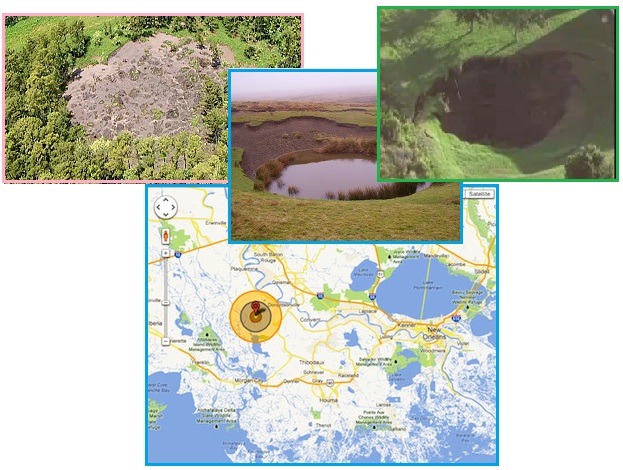
- Giant Sinkhole in Assumption Parish
August 5, 2012
http://www.klfy.com/story/19197875/sinkhole-in-assumption-parish
- For more than two months,
officials from federal to local have been unable to pin
down the source of a natural gas leak and tremors in
Assumption Parish. But a 200 by 200 foot "slurry area" has
appeared in Bayou Corne in northern Assumption Parish. The
formation of the slurry area was accompanied by a
diesel-like odor that some residents said burned their
eyes and noses but dissipated by midmorning.
A potential failure of a cavern operated by Texas
Brine Company may have caused the slurry area, or
sinkhole, which swallowed full-grown trees and denuded a
formerly forested patch of cypress swamp. Final
determination of a positive link between the failure of
the cavern and either the natural gas bubbling or the
slurry area has not been made.
This is caused, of course, by the bowing stress on the N
American continent, as the Zetas have long warned would occur.
But corporations and prior administrations have insisted that
even the US petroleum reserves be stored in these salt domes
along the Gulf. According to corporations
in the business there’s nothing to it but to do it. Water
washes the salt out, making room for petrol. What’s to worry?
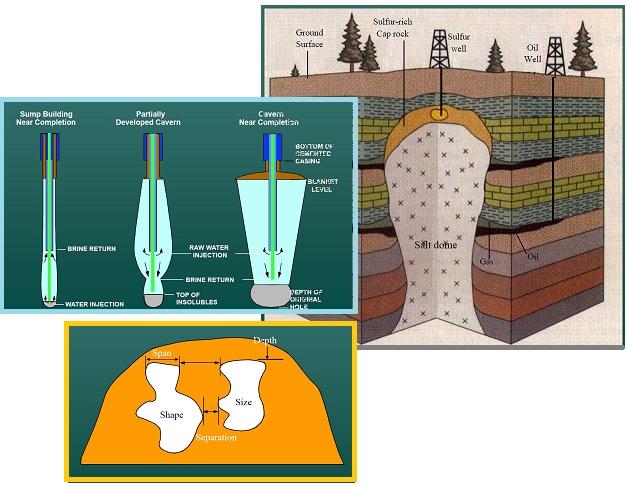
- Project Aims to Increase Oil, Gas Kept
in Salt Domes
January 4, 2009
http://www.chron.com/business/energy/article/Project-aims-to-increase-oil-gas-kept-in-salt
- It’s among a string of salt domes
along the Gulf Coast that store hydrocarbons for future
use, including the Strategic Petroleum Reserve’s vast oil
stockpiles.
- Salt Dome Storage
http://www.aglresources.com/about/gt/saltdome.aspx
- Natural gas has been safely stored
underground for more than 60 years. Salt dome caverns,
spaces hollowed out of huge salt formations approximately
a half-mile to a mile underground, are covered by
thousands of feet of rock and other materials, protecting
the facility from fire, willful damage and other hazards.
The extreme geologic conditions at cavern depth make the
salt walls rock hard and virtually impermeable – an
excellent container for natural gas, oil and other
hydrocarbons. Natural gas and other energy sources,
including oil in the nation’s Strategic Petroleum Reserve,
are stored in salt dome caverns along the Gulf Coast. Some
47 of these caverns currently store natural gas, including
26 in Texas, with more planned.
ZetaTalk Prediction
2/10/2006: The
stress on the N American plate will resolve by ripping.
Ripping the St. Lawrence Seaway open. Pulling the SE down into
the crumbling Caribbean and into the widening Atlantic, as
neither of these sinking fronts will be able to support the
edge of the weighty N American plate. The primary drama
preceding the pole shift will be the ripping action that a
plate unable to move must endure. The notable area of
catastrophe during this is the eastern half of the continental
US. From Houston to Chicago to New England, the diagonal pull
will tear the underpinning of cities and create a catastrophe
for the US that will make the New Orleans disaster appear
trivial.
Many voices are urging concern that the petrol stored in the
cavern might explode, with a force equivalent to many nuclear
bombs! Oops. If only they had listened to the Zetas! Now all
those corporations are in a rush to empty the domes and store
the petrol above ground, where it can also
explode. Tisk.
- Sinkhole: H-Bomb Explosion Equivalent
in Bayou Corne Possible
August 12, 2012
http://www.examiner.com/article/sinkhole-h-bomb-explosion-equivalent-bayou-corne-possible
- A possible breach of a
butane-filled well 1500 feet from Bayou Corne's sinkhole,
the size of three football fields, has Assumption Parish
sheriff and local residents ordered to evacuate worried
about a catastrophic explosion in the range of one and a
half B83 thermonuclear (hydrogen) bombs, the most powerful
United States weapons in active service. The hole is
believed to be close to a well containing 1.5 million
barrels of liquid butane, a highly volatile liquid that
turns into a highly flammable vapor upon release. If
ignited, the butane well would release as much explosive
energy as 100 Hiroshima bombs.
- Officials: Sinkhole Butane Explosion
Possible
August 16, 2012
http://www.examiner.com/article/officials-sinkhole-butane-explosion-possible
- If a shift of Napoleonville’s Dome
cap, comprised of sediment and rock, occurred across 1,600
feet of caprock, it could damage the casing of the well
bore that leads to the underground cavern, possibly
releasing butane.
- Louisiana Sinkhole Opens Further
Swallowing Boat, Workers
August 16, 2012
http://www.examiner.com/article/louisiana-sinkhole-opens-further-swallowing-boat-workers
- The workers were actually in the
boat, which was tied to a tree. Unfortunately, being tied
to a tree doesn't help anything when the sinkhole swallows
the tree.
The Zetas have long warned about the dangers of storing petrol
fuel. Huge explosions and fires can result, and this is a fuel
that will not be what mankind relies upon in the future. Their
advice? If you would not put a match to a gasoline spill, or a
natural gas leak, then unless you have a death wish why store
petrol?
ZetaTalk Warning
11/30/2002: We
have stated that fossil fuels will soon run out, so should not
be relied upon by survivors for the long term. We have also
stated that refineries and storage tanks of oil and natural
gas and gasoline will be broken and set afire during the
shift, creating a holocaust for all nearby. Likewise gasoline
stations, fuel pumps, and even tightly sealed tanks may
rupture and leak, also a continuing danger for any nearby.
Natural gaslines in streets will run fire along the street,
setting houses ablaze where they would otherwise not be in
such danger. Natural gas in lines under cities will cause
explosions, setting the cities on fire and burning many
trapped citizens in a painful death. We would advise all to do
what Nancy did, which is to turn off the natural gas lines in
the house, turn off at the street, and avoid gas cans or
anything that can explode. What do you gain by a few cans of
gas? A few hours of heat or light? And what do you stand to
risk in exchange? Your life? A painful death to others? Since
you are going to have to adjust to life without these
explosive fuels in any case, and soon, learn to get along
without them!
Annunaki History
In Issue 280 of this newsletter, on
February 12, 2012 we presented traces of the Annunaki in
Patagonia, in their descendants. Descendants do not come time
stamped, so how recently has it been that the Annunaki were on
Earth? They are quarantined from mankind now, though certainly
in the vicinity as their home planet, Nibiru, is outbound from
the Sun at present, and the Annunaki have been mining for gold
on Phobos, a Moon of Mars. The Annunaki built the Great
Pyramids, which by mankind’s estimation is approximately 4,000
years old, just ahead of the last passage of Planet X some 3,600
years ago.
- Great Pyramid of Giza
http://en.wikipedia.org/wiki/Great_Pyramid_of_Giza
- The Great Pyramid was the tallest
man-made structure in the world for over 3,800 years.
ZetaTalk Explanation
7/15/1995: The
Great Pyramids were built essentially as navigational devices.
The Great Pyramids were not used solely for sighting an
incoming object, as their primary purpose was to act as a
guidance system for the launches the exiled Planet X residents
would make to meet their home planet. This required precision,
as their rockets were no more sophisticated than those used to
boost man into space today, and once in space they simply
coasted until drawn into the gravitational orbit of the water
planet they owned their allegiance to.
Older evidence of the Annunaki presence continues to emerge, as
did some ancient pyramids and landing platforms further up the
Nile at Abu Sidhum. Per the Zetas, ho hum, so what, just
more evidence the Annunaki mined for gold and needed
navigational sighting devices and landing platforms. And these
ancient structures once again give no indication of how recently
they were built, i.e. how recently the Annunaki were here on
Earth.
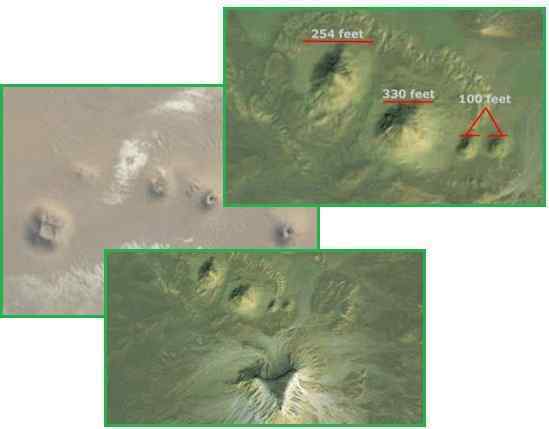
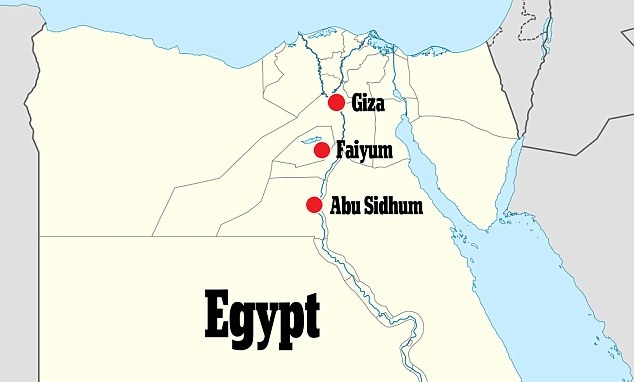
- Two Previously Unknown Sets of Heavily
Worn Down Pyramids Discovered in Egypt
August 13, 2012
http://www.dailymail.co.uk/sciencetech/article-2187788/Two-previously-unknown-sets
- Two previously unknown sets of
heavily worn down pyramids discovered in Egypt by Google
Earth. August 13, 2012. The first area sits alongside the
Nile in Upper Egypt, 12 miles from the city of Abu Sidhum.
If the plateau found there represents the remains of a
genuine pyramid, it would be the largest ever discovered.
Upon closer examination of the formation, this mound
appears to have a very flat top and a curiously
symmetrical triangular shape that has been heavily eroded
with time. The second site, 90 miles north, contains a
four-sided shape that's 140ft wide.
ZetaTalk Explanation
8/18/2012: It
should not be a surprise that various ancient structures such
as pyramids and platforms have been discovered in the Egyptian
desert. We have explained that the Great Pyramid was a
navigational device whereby the Earthbound Annunaki could
sight their inbound home planet with accuracy. Of course, each
Pole Shift changed the orientation of the Earth, so a new
sighting device would have to be constructed for the next
passage. Likewise platforms were constructed so the gold they
had mined could be easily loaded onto shuttles. If human
airports have runways to guide landing planes, the
Annunaki had objects to assist their shuttles during
landing. None of this should be a mystery, given prior
ZetaTalk on the matter.
Per the Zetas, remnants of the Annunaki hung around after they
were quarantined from Earth, and thus the legend of David and
Goliath in the Bible.
ZetaTalk Description
2/15/2002: There
is confusion about the Quarantine, as this was not a one-day
imposition such that on Tuesday, all must vacate Earth. The
giant hominoids on Planet X in fact were unaware that a
Quarantine was imposed! What they became aware of was
increasing problems while living on Earth. They considered
Earth to be a swamp, in any case, full of carnivores their
world does not have, and disease. They lost Gold shipments in
heavy storms at sea, lost slaves and soldiers to accidents,
and became disenchanted with living on Earth. They were
already on Mars, and this became increasingly attractive.
After leaving, in the main, they found mankind increasing in
numbers and tinkering with technology, tools, etc. However,
there were some who liked living on Earth, enjoyed pushing
their slaves about and raping captive women, and were loath to
leave. Thus, tales like David and Goliath have their roots in
truth.
But what about the legend of Samson, the immensely strong
Israelite who appears in the Book of Judges in the Bible?
Recently a seal from this era was discovered, dated to
approximately 1,200 BC, a younger date than the Great Pyramids
which are dated closer to 2,000 BC. Per the Zetas, Samson was an
Annunaki. Were the Annunaki on Earth at that time?
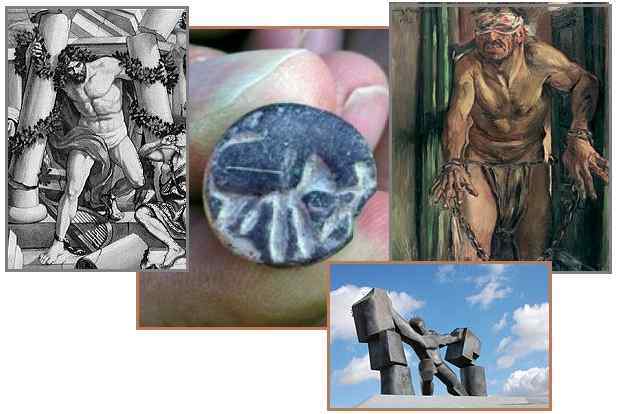
- Ancient Seal May Add Substance to the
Legend of Samson
Aug. 13, 2012
http://www.sciencedaily.com/releases/2012/08/120813103403.htm
- Tel Aviv University researchers
recently uncovered a seal, measuring 15 millimetres (about
a half-inch) in diameter, which depicts a human figure
next to a lion at the archaeological site of Beth Shemesh,
located between the Biblical cities of Zorah and Eshtaol,
where Samson was born, flourished, and finally buried,
according to the book of Judges. The scene engraved on the
seal, the time period, and the location of the discovery
all point to a probable reference to the story of Samson,
the legendary heroic figure whose adventures famously
included a victory in hand-to-paw combat with a lion. The
seal was discovered with other finds on the floor of an
excavated house, dated by the archaeologists to the 12th
century BCE.
- Samson
http://en.wikipedia.org/wiki/Samson
- Sampson is the third-to-last of
the Judges of the ancient Israelites mentioned in the
Tanakh (the Hebrew Bible) (Book of Judges chapters 13 to
16). Samson was granted supernatural strength by God in
order to combat his enemies and perform heroic feats such
as wrestling a lion, slaying an entire army with only the
jawbone of an ass, and destroying a pagan temple.
Yes, per the Zetas, remnants of the Annunaki were about in
those days, and not above leaving a motherless newborn to die
over a paternity dispute among the Annunaki. Thus, an abandoned
babe was adopted by Israelites, and the legend of Samson was
born.
ZetaTalk Explanation
8/18/2012: Was
Samson Annunaki, or did he, like David in the David and
Goliath saga, carry Annunaki genes? Where Samson is described
as being of Hebrew stock, he was not. Annunaki soldiers
were stationed on Earth during the long 3,600 year period
between the periodic passages of their home planet, and since
they had a normal life span as do humans, reproduction had to
occur. Annunaki women were thus stationed with the soldiers,
to bear young. When one of them died in childbirth, the child
was unwanted by the father as there had been a dispute over
paternity, and the babe left to die. Adopted by a Hebrew
couple, who lied about his origin, he had status in the
community but was also highly resented because of his size and
strength and fierce determination. Thus, he came under attack.
The Samson saga is a true
story, although descriptions of his strength in some accounts
are exaggerated. He could not move mountains, for instance.
Fighting an army hand-to-hand and slaying thousands with the
jawbone of an ass is describing what a fiercely angry Annunaki
would accomplish in hand-to-hand combat. Only so many soldiers
can crowd around, and the long arms of an Annunaki would reach
further than their arms, and thus his slashing landed where
their swipes missed. Could an Annunaki push pillars apart,
thereby tumbling a structure? Yes, as the pillars are just
loosely placed, not secured, and rely upon gravity to hold the
structure in place. Did cutting his hair debilitate him, as
the legends suggest? This depressed him, as hair was a status
symbol, and thus depressed he had less of a will to fight.
Mawson Coverup
Recently, in Issue 306 of this
newsletter, we documented clear evidence of the Second
Sun rising and setting just ahead of Old Sol from the
Mawson Station on Antarctica.
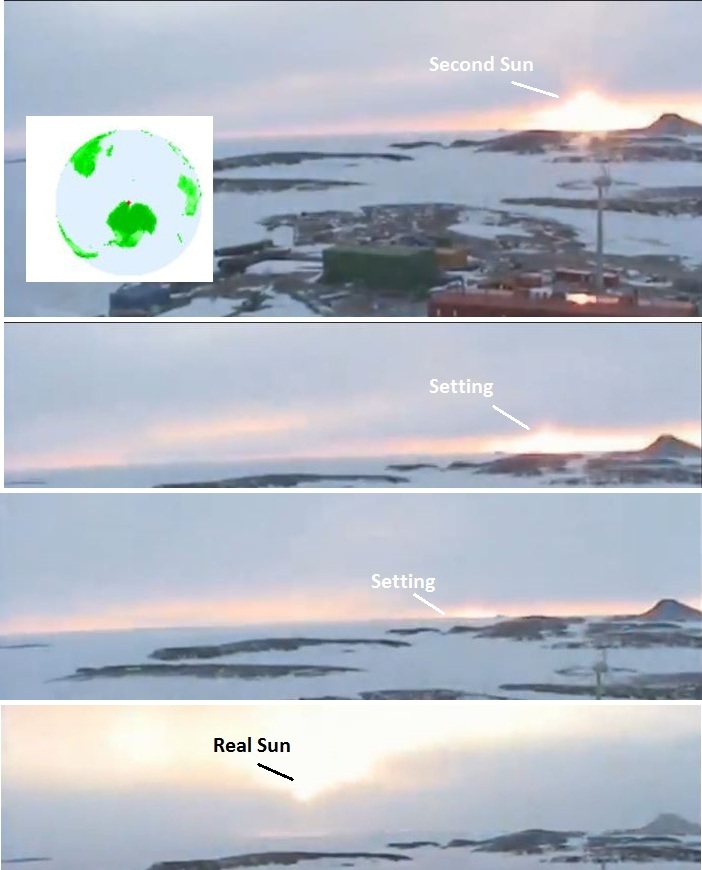
A day after this data was presented on the Pole Shift ning where
it was blogged, Mawson took the camera offline, promising it
would return. After about three weeks, it did return, but as
expected the camera had been moved.
The mount seen at the extreme right has been shifted left, so
the glare of the Sun hit the camera earlier. The windows of the
camera housing also seem to be allowing more glare, so that lens
flares fill the screen. The Sun’s crossing did not formerly
create such glares in this cam.
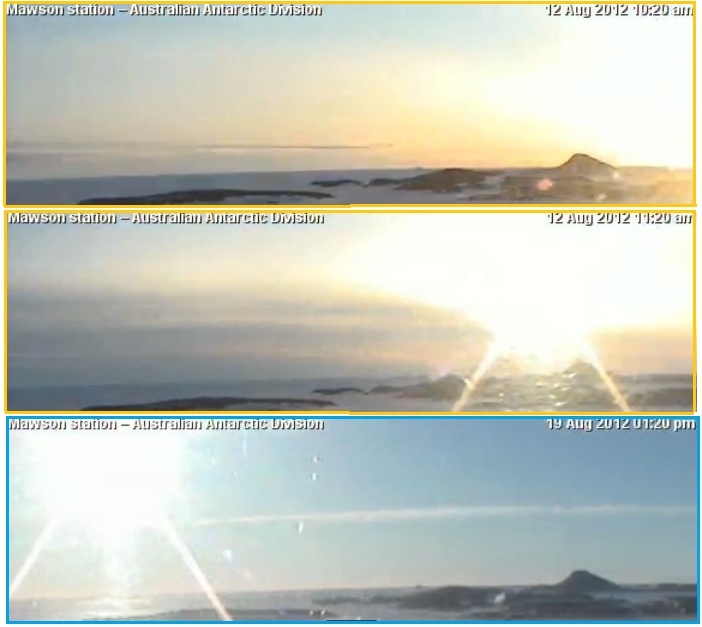
In Issue 306 we showed the light
from the Second Sun appearing at 11:20 am. But with the new
arrangement, by 11:20 am sunlight is creating so much glare that
nothing can be discerned. In fact, by 10:20 am, an hour earlier,
this is the situation.
Harvest
Time
Long time Republican Roscoe Bartlett of Maryland was featured
in the Washington Post recently for advocating that people in
cities develop a self-sufficiency attitude, warning among other
things that food could disappear from the shelves. What does he
know that he’s not telling you? Whatever he’s advising, we’re
here to tell you that stocking food is not enough! You
need to be prepared to grow and gather your own, and most
importantly, you need to know how to save seed – hands on
experience with this from container gardening if nothing else.
Are you tossing out the seeds from your Acorn Squash for the
Thanksgiving dinner, or the Pumpkin you carved for Halloween, or
scraping tomato seeds off your cutting board to flush down the
drain? Prep and save these seeds!
- The Survivalist: Roscoe Bartlett
Prepares for a Threatened Future
August 17, 2012
http://www.washingtonpost.com/local/md-politics/the-survivalist-roscoe-bartlett
- Deep in the West Virginia woods,
in a small cabin powered by the sun and the wind, a
bespectacled, white-haired man is giving a video tour of
his basement, describing techniques for the long-term
preservation of food in case of “an emergency.” The
electrical grid could fail tomorrow, he frequently warns.
Food would disappear from the shelves. Water would no
longer flow from the pipes. Money might become worthless.
People could turn on each other, and millions would die.
For those folks in the Northern Hemisphere (where the bulk of
the world’s population lives), it’s harvest time, time
to save seed! Those stressing self-sufficiency include
having plenty of seed on hand, in addition to gardening tools
and how-to books. But the best seed is fresh seed, as it
steadily degrades over time. Get a good book on this, such as Seed to Seed, and practice.

A chapter in the Finegan
Fine story portrays both the importance of seed saving
and moving to the country eventually if you are doing container
gardening in the city. Most cities are along coastlines or in
river bottoms that will be flooded. Container gardens will have to move.
- The rooftop is covered with
greenery, some kind of rooftop garden, with wines hanging
down over the edges of the roof. There is the sound of a
metal door opening on the roof, the access door to the
rooftop from a stairwell. A bent little man emerges from
the stairwell door, letting the creaking door close slowly
by itself. He heads over to a row of what looks like
cabbage, bending over it to weed the row, not noticing the
approaching houseboat. Finegan hops up to the houseboat
rooftop for a better look. “Yo, the gardens! Good day to
you. Finegan Fine here, trader. How you manage that, on
the rooftop?” The gardener freezes at the sound of a voice
so close, and so unexpected. He straightens up, as much as
his bent back will allow, and looks in Finegan's
direction. Then he puts his handful of weeds plucked from
the row down, and shuffles over to the rooftop edge. “What
kind'a contraption is that?” Finegan replies, “It's a
houseboat. Floats. I got a water wheel in the back to push
it along. Slow, but steady.”
Finegan is being given a tour of the rooftop gardens by
the gardener. “We seen the water's a'rising and dug some
good soil before it was covered. Those of us ain't never
had no land in our name. Cain't run off with the house,
but them landlords not gonna miss some soil from a flooded
yard. We use rainwater here.” The gardener is motioning
along the rows as they walk. “Tomatoes do well. Greens of
many kinds. Potatoes if you keep 'em wet. Can't get those
carrots to grow unless they's the stubby kind.” They come
to the watering system where there are hoses with holes
running down the length of the soil troughs, in the center
of each trough. There is a water tank on the roof which
had been used by the factory, raised above the roof so
there is water pressure. “This here's how we water.
Wears me out hauling the rainwater up there every time,
though. Collects in the drains over there, which'n we
blocked.”
They return to the stairwell, as the gardener wants to
show Finegan that the lower floors are inaccessible.
Finegan follows the gardener down to the next landing
where the water level is visible. “Risen to this level,
and lately slowed.” Finegan points to the rust just under
the water level. “Salt water. Salt water is corrosive.
This plant was never built for salt water.” Finegan turns
to face the gardener. He barely gets his words out before
the building starts to collapse. “You had any settling
problems?” There is a sound of metal screeching on metal.
The stairwell shutters and both men lose their
footing. A frantic scene ensues, as the gardener and
his family are evacuating. Finegan is on the roof of the
factory with the gardener, trying to harvest his crop. The
gardener is harvesting potatoes. Finegan is doing the same
to carrots, starting to tear the greens off them. The
gardener cries out, “No, no, leave some! I'll replant 'em
for the seed. Gotta have the seed.”
Finegan and the gardener are now harvesting green cabbage,
cutting this off at the root and discarding the brown and
tattered outer leaves. The gardener cries out again,
“Leave that'en. I'll replant for seed. Just those half
dozen will do.” The water starts lapping over one edge of
the rooftop guard. The gardener rushes over to the far
side of the factory rooftop, tearing off his shirt. He
picks seed shoots from carrot and cabbage plants being
used to grow seed and ties them into his shirt. Along the
sides of the factory roof the vines holding summer squash
can be seen bobbing up. The squash on the surface is
bloated and yellow, oversized and almost rotting in
appearance. The gardener cries out, “The squash!” He dives
into the water and swims along the bobbing vines, plucking
the overripe summer squash and tossing them to Finegan.
Several of them shatter when caught. “Arrrrrr! These are
rotten!” The gardener's wife rushes up to collect the mess
in a basin. She says, “This is seed! You gotta rippen it
full.”
You received this Newsletter because you subscribed to the ZetaTalk
Newsletter service. If undesired, you can quickly Unsubscribe.
|

